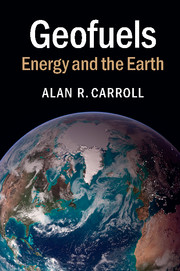Book contents
- Frontmatter
- Contents
- Acknowledgments
- 1 Introduction
- 2 The Living Earth
- 3 Warmed from Above: Solar Energy
- 4 Wind, Water, and Waves: Energy from the Fluid Earth
- 5 Covered in Green: Biofuels Basics
- 6 Fossil Farming: The Geologic Underpinnings of Biofuels
- 7 The Light of an Ancient Sun: Fossil Fuel Origins
- 8 Digging for Daylight: Coal and Oil Shale
- 9 Skimming the Cream: Conventional Oil and Gas
- 10 Stuck in the Mud: Fossil Fuels That Fail to Flow
- 11 Petrified Petroleum: Oil Sand and Gas Hydrate
- 12 Water, Water, Everywhere
- 13 Primordial Power: Geothermal and Nuclear
- 14 Out of Sight, Out of Mind: Geologic Waste Disposal
- 15 How Long Is Forever? Energy and Time
- 16 Conclusions
- Index
- References
5 - Covered in Green: Biofuels Basics
Published online by Cambridge University Press: 05 March 2015
- Frontmatter
- Contents
- Acknowledgments
- 1 Introduction
- 2 The Living Earth
- 3 Warmed from Above: Solar Energy
- 4 Wind, Water, and Waves: Energy from the Fluid Earth
- 5 Covered in Green: Biofuels Basics
- 6 Fossil Farming: The Geologic Underpinnings of Biofuels
- 7 The Light of an Ancient Sun: Fossil Fuel Origins
- 8 Digging for Daylight: Coal and Oil Shale
- 9 Skimming the Cream: Conventional Oil and Gas
- 10 Stuck in the Mud: Fossil Fuels That Fail to Flow
- 11 Petrified Petroleum: Oil Sand and Gas Hydrate
- 12 Water, Water, Everywhere
- 13 Primordial Power: Geothermal and Nuclear
- 14 Out of Sight, Out of Mind: Geologic Waste Disposal
- 15 How Long Is Forever? Energy and Time
- 16 Conclusions
- Index
- References
Summary
But of all the occupations by which gain is secured, none is better than agriculture, none more profitable, none more delightful, none more becoming to a freeman.
Marcus Tullius Cicero, De Officiis (44 BCE)Biofuels built Rome! The motive force behind Rome and every other preindustrial civilization came almost entirely from muscle (human and animal) and was thus fueled by agricultural food production. Cooking and heating were mostly accomplished by directly burning wood and other plant matter. During the Industrial Revolution we gradually moved away from biological energy sources, initially for practical reasons related to the greater energy density offered by coal and petroleum. Coal, for example, provides about twice the energy contained in an equal weight of biomass, and about eight times as much energy by volume (Figure 5.1). Oil and gas offer even larger advantages. Fossil fuels also reduced the need for human and animal labor, since higher quality fuels make mechanization more practical.
Despite its historical decline in popularity, energy derived from recently living plants continues to offer two potentially key advantages over fossil fuels. First, living plants continuously recycle carbon dioxide from the atmosphere, a process that in principle means their use should cause no net change in greenhouse gas abundance. Second, plant biomass is renewed with each new growth cycle, implying that biofuels should always be available (with certain important caveats). Increasing concern over both the future availability of fossil fuels and their inevitable net addition of CO2 to the atmosphere has therefore led to renewed interest in biofuels.
The most immediate questions for biofuels are whether their potential advantages can be achieved without sacrificing the well-known advantages of fossil fuels, and whether industrial-scale biofuels production can be accomplished without threatening food supplies or the environment. These questions are by nature complex, and informed debate requires a deeper grasp of the inner workings of biological energy systems and their interactions with the Earth.
- Type
- Chapter
- Information
- GeofuelsEnergy and the Earth, pp. 80 - 102Publisher: Cambridge University PressPrint publication year: 2015



